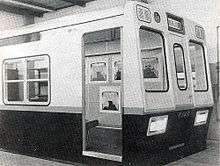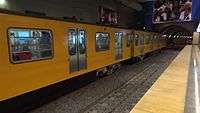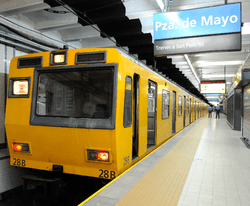Fiat-Materfer (Buenos Aires Underground)
| Fiat-Materfer | |
|---|---|
|
Fiat-Materfer at Plaza de Mayo station on Line A | |
| Manufacturer | Materfer |
| Built at | Córdoba, Argentina |
| Entered service | 1980 |
| Number in service | 95 cars |
| Formation | 5-6 cars per trainset |
| Operator(s) | Buenos Aires Underground |
| Line(s) served |
|
| Specifications | |
| Car body construction | Stainless steel |
| Doors | 4 per side |
| Track gauge | 1,435 mm (4 ft 8 1⁄2 in) |
The Fiat-Materfer Buenos Aires Underground rolling stock was built by the Argentine company Materfer - then a subsidiary of Fiat Ferroviaria - beginning in 1980 and continuing on through that decade. It was originally conceived to standardise the diverse rolling stock of the Buenos Aires Underground with the use of one model throughout all the lines. However, with the economic and political turmoil faced in the country during and following the collapse of the National Reorganisation Process junta in 1983, its production ended up being far more limited.[1][2] Today the cars serve as temporary stock for two lines, being phased out as newer models arrive from overseas.
History and overview

By the late 1970s, the Buenos Aires Underground had a vast array of ageing rolling stock - given that the different lines were developed by different companies in different periods - and the need for standardisation was becoming apparent given the increased cost of dealing with so many different models. One challenge was the use of 1100v electrification on Line A (though it was converted to 1500v in 2013[3]) and 1500v on other lines, but also the use of third rail on Line B while all others use overhead lines.[2][4]
In 1978, Materfer presented a prototype vehicle which solved the issue of the different voltages by providing a model which could be easily switched between the two voltages, though Line B would remain an independent entity in the underground network. The trains were produced throughout the 1980s for use on Line E, however due to the economic problems in the country at the time, they never attained widespread use on the rest of the network since there was not the funding available to purchase new rolling stock for all the lines.[1][2]
Current use


Over the years, the cars have seen cosmetic upgrades, as well as technical ones, such as the incorporation of Automatic Train Protection and ability to play pre-recorded messages through its speakers - which was unusually left out at the time of production.[5][6] While the Fiat-Materfer trainsets briefly made up the entire rolling stock of Line E, today they find themselves on Line D and Line A as temporary rolling stock alongside newer trains while more new cars arrive.[7] As the new rolling stock arrives for these lines, the Fiat-Materfer trains will be stored, then incorporated into Line E once again in time for its extension to Retiro station, though this has yet to be confirmed by SBASE or whether the purchase of new rolling stock for Line E would mean the complete retirement of the trains from service.[7][8]
On Line D they operate alongside Alstom Metropolis trains. The Alstom trains were originally intended to make up the entire rolling stock of the line and began operating in 2001, however due to the economic crisis in the country that year, only 80 of the 120 cars were bought for the line and the Fiat-Materfer trains were used to fill in the shortfall. In 2008, 14 more of these were eventually bought and incorporated into the line, while a further 24 are set to arrive between 2015 and 2016, meaning that the Fiat-Materfer cars will be retired from the line at that point.[8][9][10]
Similarly, the retirement of the La Brugeoise cars from Line A in 2013, as well as the presence of only 45 new CITIC-CNR cars at the time of retirement, meant that Fiat-Materfer cars needed to be incorporated into the line in order to make up shortfalls while the other 105 cars arrived from China.[11] Ironically, the line had also been converted to 1500 volts that same year to incorporate the new CNR trains so the easy 1100v to 1500v conversion which the Fiat-Materfer cars were designed to have was ultimately never needed.[3] The last of the CNR trains will arrive before 2017, and the Fiat-Materfer trains will then be retired from the line.[12][13]
See also
| Wikimedia Commons has media related to Fiat Materfer (Buenos Aires Metro). |
- Buenos Aires Underground rolling stock
- Buenos Aires PreMetro - uses trams manufactured by the same company
- Fabricaciones Militares - the only other Argentine manufacturer of rolling stock for the Underground
- Moebius (1996 film) - Fiat-Materfer trains featured in the film
References
- 1 2 Línea E: 70 años buscando pasajeros - EnElSubte, 20 June 2014.
- 1 2 3 Ferrofilatelia - EnElSubte, 6 June 2010.
- 1 2 La línea A de subte estará cerrada desde el 12 de enero al 8 de marzo - La Nacion, 4 January 2013.
- ↑ Denuncia contra la compra de nuevos coches para los subtes - Perfil, 20 July 2014.
- ↑ Piccardo desconoce que los trenes Fiat-Materfer y Siemens tienen ATP - EnElSubte, 3 September 2013.
- ↑ Instalan anuncio de estaciones pregrabado en trenes Materfer de la línea D - EnElSubte, 2 September 2013.
- 1 2 Estiman que Ciudad deberá invertir 700 millones en la extensión de la línea E - EnElSubte, 8 June 2015.
- 1 2 Metrovías oficializa quita de formaciones - EnElSubte, 4 June 2013.
- ↑ Finalizó la entrega de los Alstom Metrópolis - EnElSubte, 9 March 2009.
- ↑ SBASE anuncia nuevos coches con foto del Metro de San Pablo - EnElSubte, 21 January 2014.
- ↑ Llegaron al país dos nuevos trenes CNR para la línea A - EnElSubte, 7 April 2015]
- ↑ Hacienda aprueba contrato de financiamiento para 105 coches CNR - EnElSubte, 24 June 2014.
- ↑ La extensión de la red de subterráneos - Buenos Aires Ciudad, 6 September 2013.
